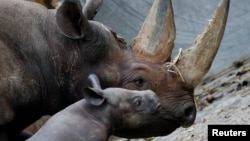South African conservationists and environmental officials went into 2014 optimistic about their fight against rhino poachers. But as this year comes to a close, the nation has set two conflicting records: both rhino slayings and arrests of suspected poachers are at an all-time high.
The Stark Numbers
As 2013 ended with a then-record 1,004 deaths, Environmental Affairs Minister Edna Molewa made a solemn pledge to her nation. "I can assure you that we will not allow rhino to become extinct on our watch," she said at a World Rhino Day parade in South Africa’s capital.
But 2014 has proven to be the worst year ever for these gentle giants, which, as vegetarians, exclusively consume grass and plants.
With the year drawing to a close, at least 1,020 rhinos have been slain in South Africa, a new record.
Those figures were as of November 20th and Albi Modise, a spokesman for the department, said the final official toll is likely to be even higher.
“Clearly the pattern that we are seeing developing was that the numbers this year are actually higher than last year, in terms of the rhinos killed,” he said, though he did not give a final figure.
Driving the blood lust? Rhino horn is prized in Asia as traditional medicine - although there is no scientific evidence it has any effect. Rhino horn can sell for as much as $100,000 per kilogram, drawing organized crime syndicates into the poaching endeavour.
Debated Strategies
Conservationist Chris Galliers, Rhino Initiative Project Manager for the Wildlife and Environment Society of South Africa, says 2014 has been brutal. He spoke to VOA News from a nature reserve in South Africa’s KwaZulu Natal province.
“It has been a very tough year, and we’re obviously very concerned,” he said. “It’s not due to a lack of efforts from a lot of people on the ground. We must say that people are working exceptionally hard on the situation. If it had not been for those efforts, then the situation would be a lot worse than what we are seeing now.”
Galliers praised the increase in arrests, but noted that that is not the entire story: prosecutions, he said, are not keeping pace with arrests,which means that many suspected poachers are getting away with it.
That is a big issue for conservationist Dex Kotze, who says he has lobbied, unsuccessfully, for legislative change. He says without that, South Africa’s government is not really serious about fighting poaching.
“They have to change the criminal procedures act. They have to change the laws,” he said. “Judges need a clear mandate from government to say if you get caught, that’s what you should look at. I mean, we have had seven consecutive years, now it is eight consecutive years, of massive rises in killed rhinos on an annual basis. Yet the laws haven’t changed. It’s crazy.”
And Galliers says rhino poaching affects not just rhinos, but the environment, the health and economy of local communities, border security and more. All of that, he says, needs to be taken into consideration.
“There’s no single intervention that’s going to stop rhino poaching tomorrow,” he said. “This is a long hard struggle, it’s a war we are facing ... And if we can’t secure rhinos as a species, a charismatic species at that, what hope is there for any other species living on this planet?”
Crime and punishment are not the only tactics at the nation’s disposal. The country is working on secret relocations of Rhino, trying to establish customs and policing relationships with Asian consumer nations, and educational outreach.
South Africa is also deliberating whether to legalize the sale of stockpiles of rhino horn, a move that Galliers says he is cautious about endorsing until he sees details.
But Modise says he isn’t giving up hope for the rhino in 2015. He cited the last major rhino population crisis in the 1960s, from which the species recovered.
“The rhino can be saved,” he said. “However the challenges we are facing today is much bigger than it was at that time because here you have a growing demand in terms of the global market, illicit as it might be in terms of the rhino horn. So our efforts this time around have to involve international players, have to involve international partners.”
None of these impassioned conservationists and experts can agree on how to best tackle the scourge. But they all agree: things need to get better in 2015.









